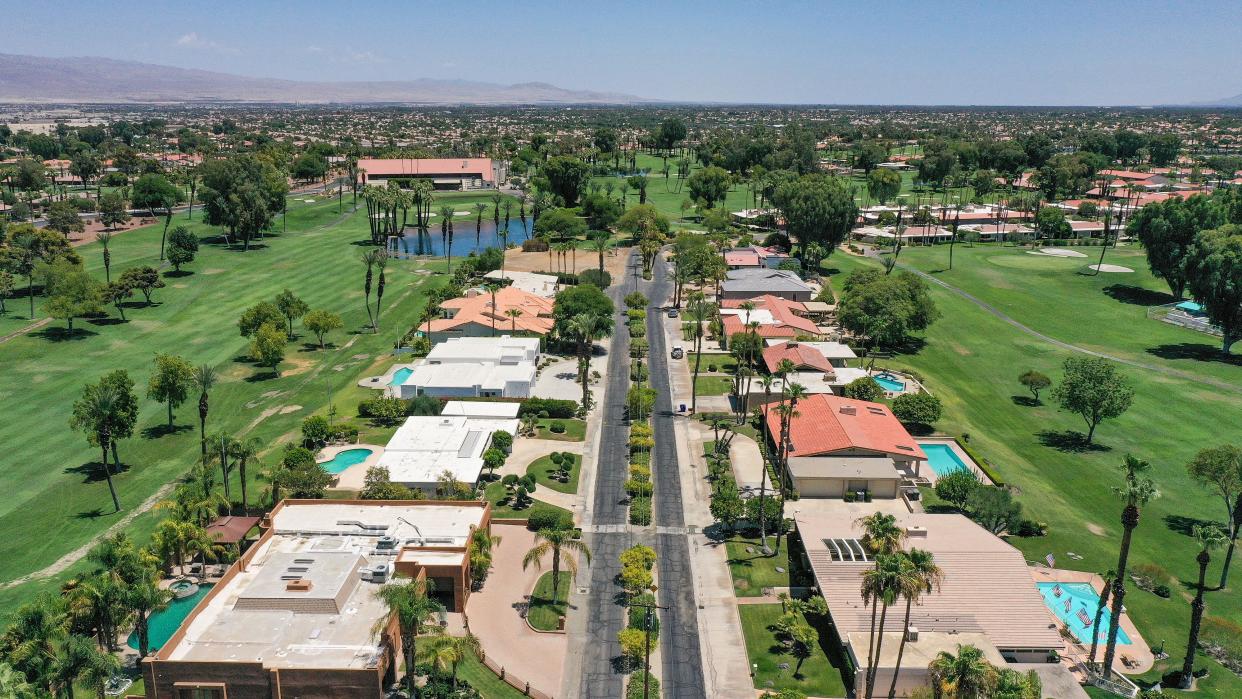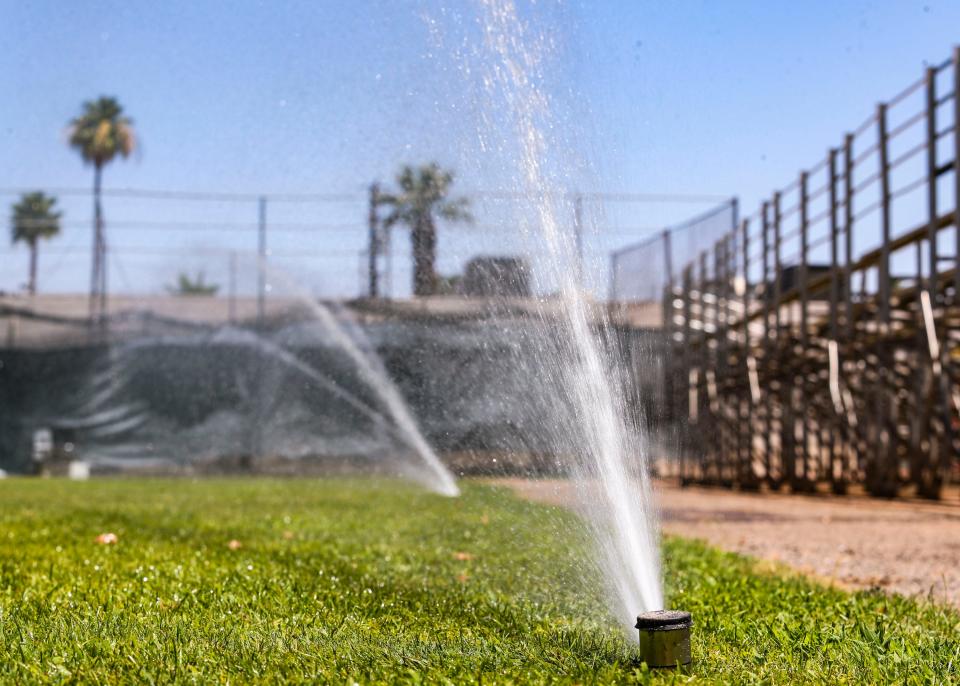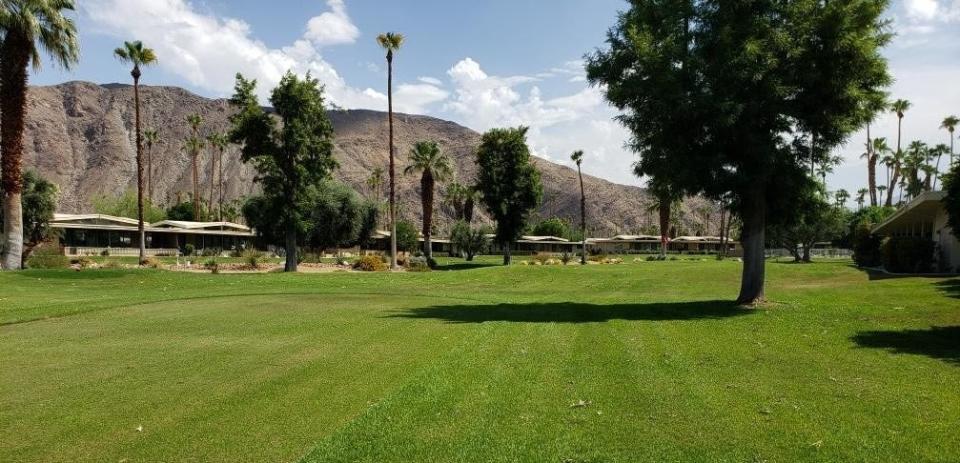In Coachella Valley, water customers still using about 3 times the state average per person

Coachella Valley water districts once again were among California's top water users in May, although some are making progress on conservation.
Just two of the six water agencies serving the Coachella Valley decreased their cumulative water use from July 2021-May 2022 compared to the corresponding months in 2020, according to data released by the State Water Resources Control Board last week.
Myoma Dunes Water Company, which serves Bermuda Dunes and a corner of La Quinta, was down by 5.4%, and Mission Springs Water District, which serves Desert Hot Springs, was down by 0.7%. In July 2021, Gov. Gavin Newsom called for Californians to reduce water usage by 15% compared to 2020 levels.
The other four water agencies all increased their cumulative water use compared to 2020. Local agencies have taken issue with the use of 2020 as a baseline, since the Coachella Valley's seasonal population and tourism were impacted by the pandemic that year, resulting in fewer visitors and less water use than normal.
"The 2020 baseline is tough for the Coachella Valley since it has a seasonal and tourist-based economy. We had dramatically less people from March through May 2020 as a result of the pandemic shutdown. We are also experiencing a much drier climate this year," said Lorraine Garcia, spokesperson for the Coachella Valley Water District.

The cumulative usage is calculated using the total gallons produced.
Of the four agencies that haven't achieved a cumulative decline in water use, two — Coachella Valley Water District and Indio Water Authority — did decrease their gallons per person per day in May 2022 compared to May 2021, although these figures were above the May 2020 numbers that the state uses as a baseline.
The statewide average was 91 gallons per person per day in May 2022.
Usage in the Coachella Valley is much higher. Three Coachella Valley water districts placed in the top 11 of about 400 water districts across the state for gallons per day per residential customer in May.
Myoma Dunes ranked fourth in May, with 352 gallons per person per day. Desert Water Agency, which serves Palm Springs and Cathedral City, ranked seventh with 273 gallons, and Coachella Valley Water District, which serves Rancho Mirage, Palm Desert, Thousand Palms, Indian Wells, La Quinta, Thermal and the Salton Sea communities, ranked 11th with 244 gallons.
Still, the Coachella Valley was not the thirstiest area in the state. First place in May was the Santa Fe Irrigation District in San Diego County with about 401 gallons, followed by San Juan Water District in Placer and Sacramento counties with 387 gallons and Vaughn Water Company in Kern County with about 369 gallons.
Drought: How can desert surf parks, lagoon resort be approved amid drought? Here's what law says
The calls for increased conservation come as climate change has contributed to the western United States experiencing one of the worst droughts on record, with a recent study finding that the current megadrought beginning in 2000 is the driest in at least 1,200 years. More than 97% of California is currently experiencing severe, extreme, or exceptional drought, according to U.S. Drought Monitor.
Californians have struggled to achieve Newsom's 15% reduction goal. But May numbers mark an improvement from March and April, when water use spiked across the state.
Statewide, urban water use in May 2022 was 3.1% lower than in May 2020, compared to increases of 18.6% in March and 17.6% in April. And preliminary numbers for June representing 30% of the state's population show further savings of 7.7% compared to June 2020.
The Colorado River region, which includes the Coachella Valley and spans the hot and dry southeastern corner of the state, was the only hydrologic region in California to see an increase in water use in May 2022 compared to May 2020. The region’s water use in May 2022 was 8.9% higher than in May 2020.
The state’s other nine hydrologic regions decreased their water use. The steepest reduction was 18.6% in the North Lahontan region in the northeast part of the state.
Cumulative usage trends
The state is using the 2020 calendar year as its baseline to see whether water districts are conserving.
So, as it looks to see what progress has been made since Newsom issued his conservation call in July 2021, it is comparing numbers to the corresponding months in 2020. That means it is judging August 2021 against August 2020 numbers, but it judges May 2022 numbers against May 2020 levels — not May 2021 levels.
Cumulatively, statewide water use is down by 2% from July 2021 through May 2022, compared to the 2020 baseline numbers.
But in the Coachella Valley, some water districts are still showing increases in water use compared to 2020 figures. For Desert Water Agency, water use from July 2021 through May 2022 increased by 10.4% compared to the same months in 2020. Coachella Valley of Water District, Coachella's Water Division, and Indio Water Authority also saw cumulative increases in water use, while Mission Springs Water District and Myoma Dunes Water Company reduced their water use by 0.7% and 5.4%, respectively.
About 100 of the 411 water districts reporting in May have cumulatively increased their water use in the past 11 months over 2020 numbers.
July 2021-May 2022 water use compared to the 2020 baseline:
Coachella Valley Water District: up 4.2%
City of Coachella, Water Division: up 6.7%
Desert Water Agency: up 10.4%
Indio Water Authority: up 3.5%
Mission Springs Water District: down 0.7%
Myoma Dunes Water Company: down 5.4%
Garcia noted that water use in CVWD is down compared to 2013, which was previously used as the baseline for conservation goals, and that use is trending downward overall. While CVWD's gallons per person per day of 244 for May 2022 was above the May 2020 amount of 210 gallons, it was below May 2021, when CVWD had 247 gallons per person per day.
Desert Water Agency changed the way it reports water use information to the state in mid-2020. It switched from reporting billing information to reporting the volume from sources, so comparing 2020 to 2022 numbers is "a little apples to oranges," according to spokesperson Ashley Metzger.
"That said, use is up since 2020. Despite the impact the pandemic had on water use during the baseline the Governor set, there is a lot of room for savings," said Metzger in an email to The Desert Sun.
Desert Water Agency's gallons per person per day number of 273 in May 2022 is also slightly up from May 2021, when it had 267 gallons per person per day.
The Coachella Valley relies on a large underground aquifer for much of its water, which local water agencies say provides a buffer from the drought conditions impacting the rest of the state.
"Desert Water Agency is not experiencing a water shortage. The local groundwater basins are managed over the long term to alleviate drought and climate change impacts," wrote Desert Water Agency in a letter to the State Water Board in May.
But the aquifer is replenished using imported water — CVWD and DWA exchange State Water Project water with the Metropolitan Water District for water from the Colorado River Aqueduct to fill recharge ponds.
New restrictions took effect in June
The May numbers do not account for several new restrictions on water use that took effect in June, such as a statewide ban on watering "non-functional" turf in the commercial, institutional, and industrial sectors that took effect June 10.
The State Water Board also adopted an emergency regulation that required urban water suppliers to implement their Water Shortage Level 2 demand reduction actions by June 10. These actions vary by district, but in the Coachella Valley, they largely include regulations like banning spray irrigation during daylight hours and requiring restaurants to only serve water upon request.
These restrictions appear to be making an impact. Preliminary data from Coachella Valley Water District shows a 10% reduction in water use in June 2022 compared to June 2020, according to Garcia.

Coachella Valley Water District and Desert Water Agency have also both increased their turf rebate amounts from $2 to $3 per square foot. Coachella Valley Water District is also partnering with Rancho Mirage to offer a $6 per square foot turf conversion rebate for customers there.
Other parts of the state have seen even stricter cuts to outdoor watering. The Metropolitan Water District took the unprecedented step of limiting outdoor watering to one day a week starting June 1 for millions of Southern California residents in Los Angeles, Ventura and San Bernardino counties. Metropolitan Water District officials have also warned that they could institute a full outdoor watering ban as soon as September if conservation does not improve.
Some other regions in the West have gone even further. In Las Vegas, a new state law requires the outright removal of the non-functional turf.
Watering thirsty green lawns continues to comprise a significant amount of California's water use, with outdoor irrigation accounting for up to 80% of urban water use, a number that can skew even higher during the summer months.
In a press release on the May figures, the State Water Board reiterated what is now a years-long plea to cut back on outdoor watering during the drought, calling it "critical to reaching our conservation goals."
"As California’s climate becomes more and more similar to what we’d see in Mediterranean parts of the world, it’s time to shift our perspective on what beautiful landscaping looks like," stated the press release.
Newsom has warned that the state may enact mandatory restrictions if significant progress on conservation isn't made during the summer.
Final water use data for June will be released in early August.
Erin Rode covers the environment for the Desert Sun. Reach her at erin.rode@desertsun.com or on Twitter at @RodeErin.
This article originally appeared on Palm Springs Desert Sun: Drought: Coachella Valley water districts remain among top water users

